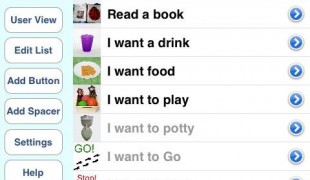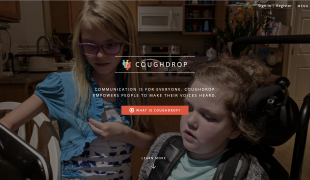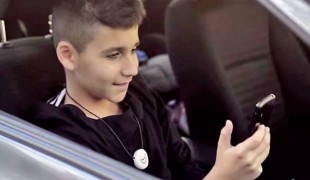- 2947
- 260
- 7
- 7
- 0
- Help Ukraine
About the solution
The app allows Mia, who cannot walk, talk or control her movements, to point out pictures of food, toys, activities and other day-to-day themes on the iPhone screen using her eyes. Mia’s parents can upload their own photos so that the system can be easily customized to Mia's needs and their daughter can feature in the images to aid familiarity.
The couple can also use recordings of their voices to announce what has been selected on screen to complete the personal touch.
The software has been downloaded by more than 1,300 people since it was made available on Apple's app store, in March 2010, and Mr Brooks has received messages from parents around the world saying how grateful they are at the freedom of expression it gives their children.
'It has given her a voice for the first time and allowed us to understand her so much better,' he said.
"Mia is cognitively alert but unable to communicate and I was afraid that as she grew she was not going to be able to tell us what she wanted".
'I had a very strong concept in my head. I wanted to create an iPhone app to take Mia's eye-pointing to the next level. Mia finds it engaging that she can see pictures of herself doing an activity which gives her a greater sense of choice and loves seeing pictures of her friends and family’.
'Also it's given us a form of reciprocal communication. Now I can ask her what she has been doing and she can reply. It's allowed Mia to become much more sociable.
'Another great thing about the iPhone is that it's portable, so we can use it when Mia is out and about’, Martin explained.
The system works by displaying four panels on the screen at a time, such as basic needs, activities, food and toys. Other options can be scrolled into view by swiping a finger across the screen.
If Mia is hungry she looks at the panel showing food and her father taps it to bring up more specific choices including her favorites - blueberries, cream cheese, crisps and yoghurt.
Although created for children with difficulties communicating caused by conditions such as Mia's or autism, the software appears to have found a use with babies as well.
'People pointed out to me that children of nine or ten months could also benefit,' Mr Brooks said.
'The application can be used by anyone who wants to communicate but cannot verbalise what they want.'
A basic version of iComm, which also works on the iPad, is free to download from the Apple store. The full version, which is usually £15.99, is currently available for £1.79.
Adapted from: http://dailym.ai/2uZmGYd
More info: http://www.miasapps.com
https://www.youtube.com/watch?v=z9aXlPWR2KE
This solution shall not include mention to the use of drugs, chemicals or biologicals (including food); invasive devices; offensive, commercial or inherently dangerous content. This solution was not medically validated. Proceed with caution! If you have any doubts, please consult with a health professional.
DISCLAIMER: This story was written by someone who is not the author of the solution, therefore please be advised that, although it was written with the utmost respect for the innovation and the innovator, there can be some incorrect statements. If you find any errors please contact the patient Innovation team via info@patient-innovation.com
-
-
645
-
0
-
8457

Father invents iPhone app to aid his son to communicate
COMMUNICATION: Communicating, whether by speaking, listening, or other means
CAREGIVING
Pitt Hopkins Syndrome
App (Including when connected with wearable)
Building Supportive Community Relationships
Promoting inclusivity and social integration
Improving Speech and Communication
Caregiving Support
Child and Adolescent Psychiatry
General and Family Medicine
Neurology
Pediatrics
United States
-
-
-
310
-
0
-
3473

Brian Whitmer, a software developer and father, created a communication system for his daughter with Rett Syndrome.
COMMUNICATION: Communicating, whether by speaking, listening, or other means
Neuromuscular Disorders
Videogame
App (Including when connected with wearable)
Enhancing health literacy
Managing Neurological Disorders
Building Supportive Community Relationships
Promoting inclusivity and social integration
To improve Treatment/Therapy
Preventing (Vaccination, Protection, Falls, Research/Mapping)
Raise awareness
Caregiving Support
General and Family Medicine
Internal Medicine
Neurology
Pediatrics
Physical Medicine and Rehabilitation
United States
-
-
-
566
-
0
-
8724

Father creates app to help son who stutters
COMMUNICATION: Communicating, whether by speaking, listening, or other means
Stuttering disorder
App (Including when connected with wearable)
Online service
Stuttering
Improving Speech and Communication
Caregiving Support
Child and Adolescent Psychiatry
Neurology
Pediatrics
Physical Medicine and Rehabilitation
Israel
-
 en
en